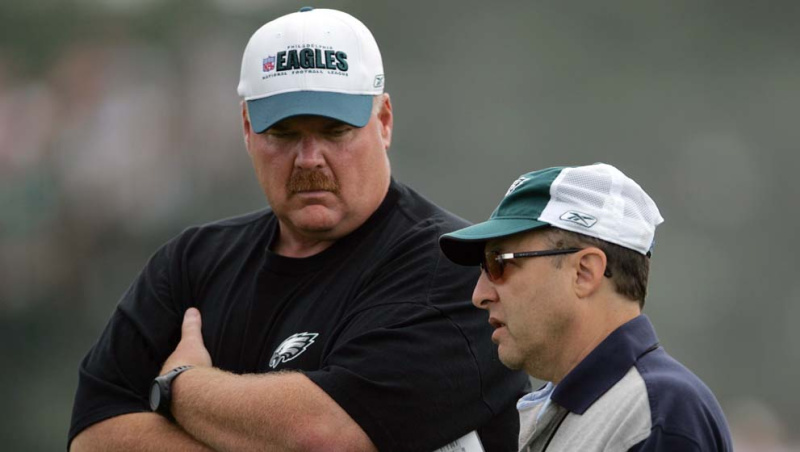Breakdowns
11/17/21
6 min read
NFL Teams Can Maximize Success With These Two Philosophies

Every smart football team will establish their keys to winning and losing. Once these keys are established, the nature of the decision-making process becomes more rooted to a specific path. Let it be known that no metric or key will cause 100% success or even individually lead to success. More so, establishing and following the correct philosophy will lend a chance at winning at a higher rate.
The philosophy that we followed during my years within the league was driving our decisions based on two premises: averaging a higher yard per pass attempt than the opponent, and having the lead at halftime or a 7-plus point lead at any point within the first half.
These premises drove every choice we made as a franchise, from hiring a coach, hiring the staff, free agency, the Draft, and game planning on a week-to-week basis. Looking at a year at a glance, a three-year period of time or decades, these coincided the most with winning.
We found that the team that had the higher yards per passing attempt (YPPA) within a game was winning between 80-90% of the games within each year. Likewise, when we did a similar study on the nature of first half leads (or leads of 7-plus within the first half), those teams were winning between a 75-80% rate. Currently in 2021, teams with the higher YPPA within a game have won 73.33% of the games with a record of 110-39-1.
Following this process, the game-planning on a week-to-week basis was determined. We would be aggressive in our play calling to get the lead by halftime and then play more conservatively with the lead.
With this plan being known, we had to utilize our strategy in free agency and the draft to put the proper pieces on the team to be able to play this style efficiently. This meant not only on offense, but restricting others from playing the same style of offense via our defense. We wanted a fresh and aggressive defensive line that would attack from the first whistle. We wanted to pass to get the lead, score early and run to keep the lead.
The nature of our process had to be followed by those making the game day decisions as well as those making the team building decisions. The Head Coach and the coaching staff to be hired had to be aligned on this truth. During the offseason, our goal was to control both lines of scrimmage. We would get great offensive linemen who would be fresh and active early in the game, along with a strong defensive line to create pressure. We felt the way to be good was to get a really good QB and control both of the lines of scrimmage. While more factors go into being great, we felt those made us good.
Based on these philosophies, our coordinators would need to dial up aggressive play calling early in the game. Andy Reid and the front office always had the ideology that the notion of having a “balanced” offense was over utilized. We found that it is not how balanced the offense was, it was the efficiency of the play calling. We used the mantra of “it’s not how many times you ran the ball, but how effective you were when you ran it.” From the first whistle, if we had both a well-run passing attack and running attack, the defense could not ignore either facet. Naturally, we fell into the rate of running about a third of the time.
While it would be too predictable to begin each game with such, Andy Reid always wanted to take a shot to open up the game. We would vary the approach, but knew that the use of play action as well as taking a shot early within the game was the way Andy liked to coach. If the defense thinks it is possible for the offense to run the ball, then the play action is just as effective, whether we ran the ball or not. We came to the consensus that play action passing was always better for our offense than not play action passing, hence why we used it at such a high rate. We could not use it on every down, or it would be meaningless, but our usage of it was heavy.
Again, the commitment to our findings did NOT guarantee us wins, it just gave us a better chance of winning week-to-week, which every team is looking for.
This begs the question, if the numbers are known, then why isn’t this every team's creed? Interestingly, while I do not have the numbers solidified, I would venture that about ⅓ of the league follows these same philosophies now, and often they are the good-to-great teams. This is comparable to about 10-15% of the league if you were to ask me the same question 4-5 years ago. The teams that do not follow these rules currently, the Steelers and Colts (in most games), play a lot of small ball offense (running and short passing). The offense can still be effective in achieving success within the YPPA or 1st half winning metrics, it just rests on mixing in deep passes to vary the offensive structure and often the need for exceptional YAC receivers. A lot of coaches follow what they have learned or who they have learned from as well as tactics that have made them successful in the past. This is the essence of why only ⅓ of the league is thinking the way we did.
I cannot stress enough the understanding that these ideals did not mean that we can’t vary the game plan based on our opponent, it simply meant that at the end of the day, if we wanted to feel like we were putting ourselves in the best position to win, we structured all decision-making on these premises. If a team had two of their starting IDL players injured with poor depth, of course we would alter our game plan, but made sure we stayed true to what we wanted to achieve.
It was simple for us if we followed the two rules: achieve a higher YPPA than the opponent and a halftime lead and a 7-plus point lead at some point within the first half, and we would be successful. The nature of these ideals will change as more teams adapt the premises, and then the smart, forward-thinking teams and staffs will find the next iteration.








